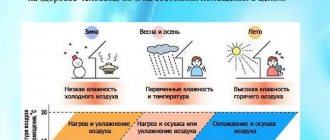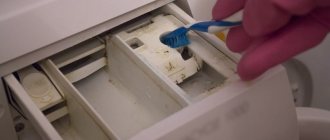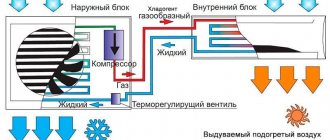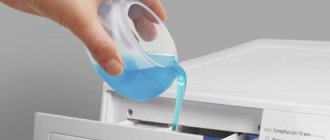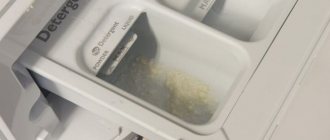A modern air conditioner cools or heats the air in the room; you choose the operating mode and temperature. Also, some air conditioner models are equipped with ionization and air purification modes. But among budget devices you are unlikely to find split systems with built-in humidification, although you have probably heard or read how an air conditioner can dry out the air.
In this article we will briefly discuss whether air conditioners dry the air during standard operation and how you can adjust the humidity in the room.
Normal indoor air humidity
Current sanitary rules and regulations provide for an acceptable range of air humidity in residential premises from 40% to 60%. In the average climate zone, the natural rate is around 70%. A refrigeration unit can reduce it to 20-30% in a couple of hours of operation.
For comparison, we can take the Sahara Desert as an example. Air humidity in this area is 30-50%. It's dry and hot here. High temperatures and humidity create a stuffy feeling in the room.
Low humidity of air masses affects the human condition, affecting:
- the ability of the lungs to absorb oxygen;
- skin elasticity;
- condition of mucous membranes;
- general well-being;
- performance;
- development of allergic reactions to synthetic fibers, wool and dust, which were previously associated with water.
When low humidity is maintained for a long time, wooden objects dry out, the glue in books loses its basic properties, and the paper becomes brittle.
However, high humidity is more dangerous than dry air. The air must be very dry to cause harm to humans. Achieving this using a standard household air conditioner is quite difficult.
Any split systems dry the air when cooling. Professional devices have a humidification function. However, they cost several times more.
Where does moisture go when air is dehumidified?
To answer the question “where does moisture go when dehumidifying the air?”, you need to understand that an air conditioner is usually used to reduce the air temperature. However, as the temperature decreases, the humidity level also decreases, and how! To understand how this happens, let’s remember what “relative humidity” is. From the school physics course we know that this is the ratio of the amount of water contained in the air at a given temperature to the maximum amount of water at a given temperature in the form of steam. Humidity is measured as a percentage and actually shows how much moisture is still missing for condensation to begin at a given temperature, i.e., the transformation of steam into liquid. Accordingly, the higher the air temperature, the more moisture it can hold. The lower the temperature, the faster condensation falls (steam turns into water).
The problem of dry air during air conditioning is relevant both at home and in the office.
As air passes through the air conditioner, the air temperature decreases. The air can no longer hold the same amount of moisture. The cooled air returns to the room and is heated, and its relative humidity will decrease significantly. This fills the room with very dry air. Excess moisture condenses and is discharged outside through the drainage tube. They are easy to spot on the walls of houses or office buildings. Essentially, we see how much water the cooled air loses.
general information
The optimal air humidity in a living room is 50-70%. A standard air conditioner operating in cooling mode can reduce air humidity by up to 30% within a few hours of continuous operation.
To get a feel for the level of humidity you'll get from your air conditioner, imagine being in a desert area with scorching sun and no water. In such areas, the standard air humidity is no more than 40-50%, and this is the lower threshold for residential premises. With such humidity, you will feel short of breath and dry mouth.
And if such low humidity persists for a long time, the human body will turn on self-defense mechanisms. At best, your general well-being, sleep and performance will deteriorate, and at worst, an allergy to wool, dust and other allergens will begin, even if you have not suffered from this disease before.
But you must understand that no air conditioner can dehumidify the air so much as to cause serious harm to health. But it may well affect overall well-being by increasing the amount of dry air in the room. A standard split system dries the air by approximately 20% within 3 hours of continuous operation.
Why do air conditioners dry the air? It's all about the principle of its operation. In cooling mode, the device sucks in warm air directly from the room, subsequently cooling it and sending it back into the room. In this case, condensation forms, i.e. the air loses some of its natural moisture.
When is low humidity useful?
Low humidity is not always synonymous with poor health. If you live in the subtropics (for example, in Gelendzhik), then you will most likely need this property of the air conditioner. In such regions, air humidity traditionally remains at 70% or more.
In such microclimates, dehumidifiers are often used rather than humidifiers, which is why air conditioners are very popular. They not only cool, but at the same time reduce air humidity. If you do not dehumidify the air, a person may develop allergies and mold may begin to grow in his home or office.
Operating principle of the air conditioner
The operating principle of the air conditioner is as follows:
- Split systems have indoor and outdoor units. When the air conditioner operates in cooling mode, freon (refrigerant) is pumped into the radiator in the outdoor unit. It heats up due to pressure. The heat from the radiator escapes into the atmosphere.
- The cooled freon is sent to the indoor unit. Here it expands sharply, due to which its temperature decreases, and the air in the room gives off heat to the refrigerant.
- Condensation appears on a cold heat exchanger , which is cooled water from the air in the room.
- The liquid is then drained out.
To understand how air conditioners humidify or dry the air, it is worth considering the principle of their operation in different modes.
conclusions
When planning to choose climate control equipment with an air dehumidification function, preference should be given only to proven manufacturers from Asia and Europe. Before purchasing, you should definitely study the technical characteristics of the model, and also compare them with the parameters of your room, since the ability of the device to cope with the task will depend on this.
The installation of a split system should only be entrusted to qualified craftsmen who can carry out the work competently, in strict accordance with the requirements of the factory regulations, including carrying out the necessary commissioning work. When selecting, you should also take into account recommendations from the sales consultant.
Why does the air conditioner dry out the air?
It is difficult to imagine a comfortable life without an air conditioner, but this device can cause health problems, or more precisely, dry air when the air conditioner is used regularly. Have you noticed that any device certainly has an outdoor unit with a hose that removes moisture? Where does it come from?
Why does the air conditioner dry the air in cooling mode?
The reasons why the air conditioner dries the air in cooling mode are extremely simple to explain: warm air from the room is sucked into the device and cooled. During sudden cooling, condensation is released, i.e. the air loses some of its moisture. The drainage system takes it outside and dumps it, unless it is an expensive model with a humidification function.
A decrease in humidity can have both negative and beneficial effects on human health. The result depends on the climate in the region. In the subtropics, air humidity can greatly exceed optimal levels for humans. For example, in Sochi it fluctuates around 76-78%. This humidity is much higher than a comfortable level.
In some cases, an additional dehumidifier may be needed, which, together with the air conditioner, will reduce the concentration of water in the air to the optimal range of 40-60%.
In addition to making you feel worse, high humidity leads to allergies and the development of mold. The risk of spreading infections in such conditions increases.
The atmosphere in the room becomes stuffy due to high humidity. In cooling mode, the air conditioner can increase the performance and improve the well-being of residents.
How to Maintain Humidity
In what ways can you humidify the air when long-term operation of the air conditioner is necessary:
- Set the split system to a temperature that is not much different from room temperature.
- Program at least 24 degrees.
- Install special humidifier devices.
- Place containers with water, or even better, an aquarium. But this measure may not be enough.
- Choose air conditioners with additional cleaning and moisturizing functions.
- Produce indoor plants with wide leaf blades.
- A quick way to increase humidity is to hang wet towels.
- Ventilate the room daily.
- Don't forget about wet cleaning.
Take care of your comfort by cooling the air to optimal temperatures while maintaining humidity. Do not use the split system constantly; turn on the air conditioner only when necessary.
Is it safe to constantly dry out the air?
In an hour of intensive operation, the air conditioner can reduce the humidity to 30 or even 15%; the skin and mucous membranes suffer from dry air, which is not safe if the air is constantly drying out. Allergy sufferers have a particularly difficult time dealing with dryness. More serious problems: the lungs absorb oxygen worse, blood clotting increases.
Dryness spoils furniture, books, and negatively affects the health of pets and plants. But all this only manifests itself with regular and long-term use of the air conditioner.
Results
Do air conditioners dry the air? Definitely yes. But this only happens if you use the device for long hours without a break. In other cases, air humidity decreases, but not so significantly.
You can use additional humidification measures if you feel generally unwell. By the way, residents of the subtropics are happy to use the ability of the air conditioner to dry the air, since in this region the humidity is always higher than normal.
Air conditioner heating problems during cold periods
The air conditioner should be turned on for heating in the off-season, when the heating period has just ended or has not yet begun. It is during this period that the system will be most effective. At the same time, the maximum values of temperature parameters outside, when it is permissible to use the heating function, are indicated in the technical documentation. Using the system at a temperature below the permissible level will lead to breakdown, so experts recommend storing the split in winter. When operating at unacceptable sub-zero temperatures, the following may occur:
- The defrosting system in the outdoor unit, when activated, leads to the formation of ice in the compressor-condensing unit, which leads to breakage of the fan blades.
- freon, which did not have time to evaporate in the heat exchanger, enters the main line. Next, the freon enters the compressor, which causes water hammer. This leads to system failure.
- The compressor may overheat when operating in cold weather. Further, when the liquid refrigerant gets inside the housing, the compressor freezes.
Look under the curtain
If the air conditioner stops blowing at all, or the blowing force has noticeably decreased, the problem is in the fan. Check if it rotates. To do this, look under the curtain. If the fan spins slowly and makes a cracking or rustling noise, there is most likely a problem with the bearing.
If the fan is standing still, there may be three reasons:
- The bearing has failed;
- The motor broke down;
- The fan motor is not receiving electricity.
The first thing to do is remove the front cover and fan. If after this the motor works normally, the bearing needs to be replaced. You can do this yourself.
If after removing the fan the motor rotates slowly, it needs to be replaced. If it does not rotate, there are two options:
- The motor is not receiving power;
- The motor is broken.
You can check the power supply with a regular indicator screwdriver. If it is, the motor needs to be replaced. If there is no power, check with the indicator whether it is supplied from the board. It is possible that the problem is in the wiring going from the board to the motor. Replacing it may help.
If there is no power on the board, everything is complicated. Without good knowledge and skills in working with electronics, you will not do anything. You'll have to call a specialist. This can be done on the Profi specialist search portal.
Advice
There is no point in looking for the original fan motor of the indoor unit. In 99% of cases you can choose a universal one. The main thing is that it matches the power, size and seating.
Universal fan motor for the indoor air conditioner unit.
Switching the air conditioner to heat
Air conditioners should be operated in strict compliance with the most necessary standards - this action will ensure that the service life is extended to the maximum, and also relieves owners of climate control equipment from the need for expensive and frequent repairs, which, as a rule, are carried out with the replacement of expensive parts such as a compressor or control board.
To set the air conditioner to heat (heating), you must:
Option 1:
1) Look at the remote control, there is a “MODE” button (on some remote controls it is hidden by a lid).
2) Press the “MODE” button until the “sun” icon or the inscription “HEAT” appears on the display.
3) Raise the temperature to the desired temperature.
4) When changing modes, hold the remote control towards the air conditioner so that it receives signals as you configure and emits a confirmation signal.
It is also possible to make all of the above settings on the remote control and then point the remote control at the air conditioner and press the “ON” button.
5) Wait about 5 minutes, or go have tea.
6) In heat mode, the fan of the indoor unit does not turn on immediately!
Option 2:
1) We look at the remote control, there is no “MODE” button, but there is a button above which there are symbols: “snowflake”, “fan”, “droplet”, “sun”.
2) Choose “sun”.
3) Set the temperature above the room. (Example: the room is 20 degrees - set it to 25 or 27).
4) Just like in option 1, we turn on the air conditioner, it should squeak with a characteristic sound differently for everyone. When the wired remote control is usually silent, the lights on the air conditioner light up when turned on.
5) Let's go have tea, if you don't want to just wait for five minutes.
Option 3:
Your remote control does not display “HEAT” or the “sun” icon, but other modes are displayed.
This indicates that your air conditioner is not capable of bringing heat into your home. It only works for you in the cold.
Option 4:
You are sure that the air conditioner is warm-cold, and not just cold.
You have completed all the operations described above.
The air conditioner is turned on, the heat mode is set, the temperature is raised above approximately 30*C, the air conditioner beeps or the lights on the indoor unit come on.
The air conditioner does not provide heat and has been on for 30-60 minutes.
I'm sorry, but you need your air conditioner repaired.
Before installing the air conditioner, you need to study the instructions in detail, which indicate how best to perform these actions, as well as how to turn on the air conditioner on heat. Experts advise not to skimp on such important actions as installation, but to trust the professionals. But you need to figure out the basic functions yourself.
When is it needed?
Dehumidifying a room may be necessary in several situations:
you live in regions characterized by a humid climate. If you do not use dehumidification, this can lead to unpleasant consequences: swelling of wooden doors, “lumpy” appearance of books, magazines stored indoors, and more.- the apartment was flooded and you want to dry it out after this unpleasant incident.
- you do not tolerate high humidity well. This often happens to people who grew up in dry climates. Then they moved to more humid regions, for example, to the south.
Need for hydration
Until recently, air conditioning was perceived solely as a cooling device. A hundred years after it came into use, the capabilities of this technology have increased significantly. Modern air conditioners effectively purify the air. In addition to creating coolness, they acquired a heating function. The advent of an air conditioner with a humidifier made it possible to bring the indoor microclimate to perfection.
Environmental humidity has a great influence on the human body. Its changes are reflected in:
- well-being;
- performance;
- condition of the skin;
- lung function, etc.
Established sanitary standards determine a comfortable indoor humidity level within 40–60%. In the summer heat, the upper limit shifts upward. More humid air is necessary for people suffering from lung diseases and young children. A dry atmosphere is the scourge of modern offices, where a large number of people accumulate in a small space for a long time.

